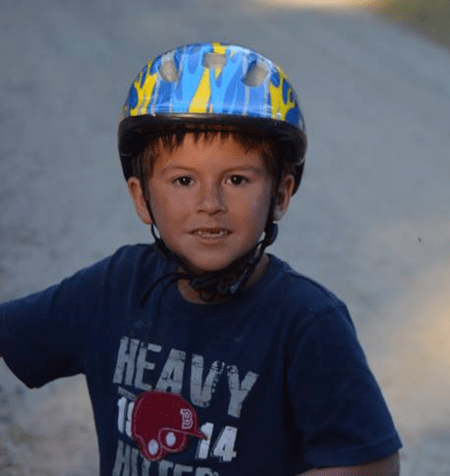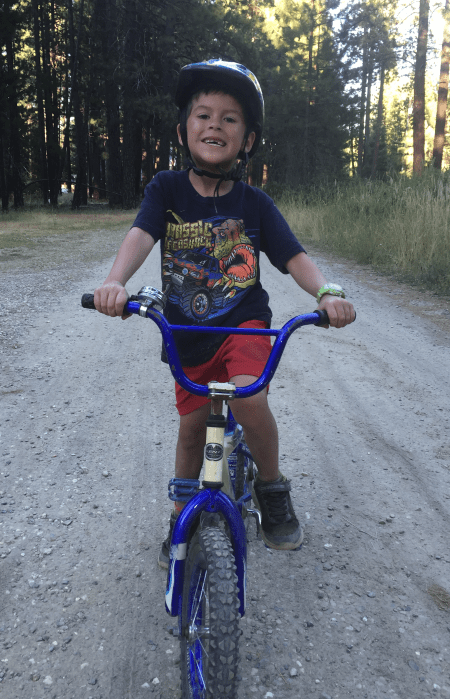Biking with Ninja Turtles: Exploring Boundaries with Kids
Written by: Lisa Tobe, Executive Director, Wildflower Consulting
I lost my six-year-old son Mateo under a yellow helmet with a face-cover. I could see his little hands and knee knobs stick out from what looked like black Kevlar body armor. My friend, Thea, stood beside him explaining the gears, throttle and brakes on the blue four-wheeler their seven-year-old son Trey rides. Mateo nodded gravely. I watched the side of his helmet bob up and down in slow, short movements. She had his rapt attention, but I wondered if he’d absorbed the directions. I hadn’t.
Instead, I thought, “Oh crap, am I really going to let him ride that four-wheeler by himself?” I’d been flooded with panic about the idea of broken bones, concussions and spinal injuries. Up until then Mateo had only ridden a bike attached to mine, a three-wheeled Green Machine that could do a wicked skid at the bottom of a hill or a red, battery-powered, plastic race car that barely moved across our gravel driveway.
Thea lives outside Nucla, a rough and tumble Colorado outpost with a great view of the LaSal Mountain Range. Kids run around outside unsupervised starting at a young age, the outdoors their only playmate when not in school. Unlike their urban/suburban counter-parts, these children have hayfields instead of soccer leagues and ponds instead of spray parks. When we first arrived, Mateo did not want to ride the four-wheeler period, so Trey proudly walked him around his family’s 22-acre ranch. We told them to be back before dark. By then, Mateo and I were several days into our cross-country trip to Quincy, California, a small town I lived in for almost a decade before returning home to Kentucky. Thea and I hadn’t seen each other since before we became moms. We sat on their porch catching up while the boys explored.
I’m a parent-in-training. I had Mateo when I was forty-one. I have been reading books about parenting since before he was born; books that told me how to be pregnant, how to give birth and how to raise him. They talked about attachment, strong-willed children and the whole-brain approach. The authors provided advice about how I could make Mateo happy, smart and compassionate, among other things. I read these books in what we in the south call ‘fits and starts’ whenever I got overwhelmed with his behavior. I thought if I followed their guidance, Mateo would be this perfect, happy child that turned into an amazing man. But I’m learning that parenting is as individualized as our DNA.

Mateo wearing his bike helmet. Photo credit: Melissa Simmons
I raise my son in a little village of helpers, which includes my parents. My dad has much more patience with Mateo than he ever did with his kids and perhaps counter-intuitively seems more afraid of bad things happening to Mateo than he did with us. My brother, Artie, and I grew up in the relative freedom like most children raised in the seventies. We scuttled up trees and scurried around the streets and woods in our neighborhood with impunity. We had few rules:
- Tell our parents where we were going;
- Stay within a one-mile radius; and,
- Return home for dinner, when it got dark or when dad whistled.
My parents warned us about cars but never about people. We biked over a mile to school alone as young as seven, and by eight we were allowed to go on solo hikes around our cabin in Western Kentucky. During these excursions, I imagined being an Indian Princess hunting for food or a race car driver flying around the speedway. I felt fearless.
While my parents follow my lead, we have complex generational and personal differences about raising children. They placed a television in Mateo’s room at their house and give him desert after every dinner, often consisting of ice cream with multiple toppings. Both are remnants of my childhood.
Both my parents and I want Mateo to be independent. We know that everyone thrives in the I-can-do-it moments when Mateo learns sometime new. It’s just that we have differing opinions of independent, which have become increasingly divergent as Mateo gets older.
My parents worry about losing Mateo. They asked me to nail Mateo’s first-floor bedroom windows shut. I let Dad drill holes, but kept the nails on the window sill. I wanted Mateo to feel the breeze moving through his room.
As young as two, I took Mateo traipsing through the creeks by my parent’s house. He loved playing in the water and chasing elusive creatures that squirted past his chubby legs. At first I held his hand, afraid he might drown in the 6 inches of tepid water that made up our latest playground. But eventually I let go, following closely behind as he rambled and fell among the brown and green algae covered rocks. The water splashed around him before soaking through his blue shorts. Mateo cried at first. But when I extended my hand, he let me pull him up and tumbled uncertainly forward trying to offset his waterlogged diaper. When Mom saw our appearance, worry lines deepened around her mouth.
Before our trip, I had started giving Mateo a little more room. I exercised during his swim lessons or went biking during his soccer practices. I’d let him go to public restrooms without supervision. At first I hovered outside the door. Eventually, I had him meet me back on a certain aisle or rejoin me at a restaurant table. I admit that each time I saw him walking back, I felt relieved. I also started feeling less trapped by the crushing public perception that a child always has to be supervised.
Mateo and I have never had a long conversation about physical boundaries, just to stay away from the street and ponds. He also has some natural fears that keep him in our yard. I work at home and can often see him from my office window, where a collection of ramshackle fences border our acre in Louisville. Gaps have begun to emerge in the black wooden fence that folds around the side and back of our yard. Several poles lean in or out pulled off center by time and weather. Some slats, held in place by a stubborn nail or two, scatter at odd angles. A wire fence runs half way up the other side of our yard, separating us from a pond and horses. Cars and trucks rush past on a busy street in front of our house, parents running errands or construction workers expanding a subdivision that used to be woods. I’m told that our eighty-year-old house used to be a school and that the fields that surround it were filled with trees before a new owner decided they would get in the way and cut them down.
I mow about 1/3 of our yard. Tall grasses and wild plants grow in the rest. My mom calls them weeds. Mateo pretends they are a rain forest, although I have to admit he’s hardly ever in that part of the yard. Mostly, he stays around his play set and trampoline, beside the house where the grass is cut. I don’t worry too much when he roams out of sight. Like my outdoor cats, I figure he’s not far.
I could only imagine what my mom would do if she’d been standing there when Mateo got on the four-wheeler. After giving him directions, Thea threw her legs over the seat behind Mateo holding onto the steering wheel. She gently coached him. Then she let him drive alone at the top of her driveway where he hopscotched across the gravel as he got used to the engine and the brakes. After about three wide circles, Mateo stopped in front of us, his learning energy depleted. He wanted Trey to take him on a ride. They headed off in dust covered cloud energy. He came back sweaty and ecstatic.
“Mama, mama,” he said tumbling in the house.
“Yep.”
“I’m going to ask Santa for a four-wheeler.”
“Oh?” I grinned. “You’d better tell him to bring 22-acres with him too. There’s nowhere to ride a four-wheeler at our house.”
“OK, I’ll ask.”
“I don’t think it will fit in his bag.”
“But Mama? Maybe Santa can have someone else drop it [the land] off, and then he can bring the four-wheeler.”
“You can always ask.”
More and more lately, I have noticed that Mateo wants both me and his independence, a complex need that we have been sorting out in increments. Still there’s this complicated mix of teaching Mateo to ask for help and letting him just go for it. When we stopped at my friend’s place just off Donner Pass in the Sierra Nevada Mountains, Mateo made himself home in the wood-covered lot. He scrunched himself up the house-sized granite boulders.
“Do you think I can get down that way?” Mateo pointed down what appeared to be the equivalent of a straight-edged cliff.
“I think you might. If you miss, it will hurt. It’s your choice.” This is standard refrain when I’m unsure.
Mateo peered over the granite face before heading back down the same way he’d come up. I never know what he’ll decide. Thus far his biggest injuries have been scratches and bruises. It probably works this way because of two reasons, he actually does have a pretty good handle on his limits and I won’t let him do anything that seems like sure death. I really like this natural check-in process he has developed. I feel safer because of it, so I continually push all our boundaries, the adult comfort and the child’s will. He has done these new things alternating between wild abandon and mild trepidation.
I watched for a few minutes. “Don’t kill yourself,” I told him before I walked into Seth’s house to sort our laundry.
After two weeks, we finally reached Quincy, a town of 6,000. My neighbor offered him the use of any of their bikes, a balance-bike without petals, one with training wheels or a two-wheeled bike. To my surprise, Mateo picked the big-boy bike.
Last year, he’d tried to learn to bike on our gravel driveway in Kentucky. It had been a hot late spring day. Neither of us had any idea what we were doing, me teaching him to learn to ride without training wheels or him learning. I only vaguely remember learning how to do this. I might have been five or six, no helmet, no knee or elbow pads, just a pile of dusty skin and determination. I’m sure my brain had been flooded with all those confusing chemicals that told me to be excited and afraid. I’m sure there was blood and Band-Aides before the triumph. Mateo wore full riot gear including wrist guards. When he pushed down on the petal, Mateo lurched sideways and threw out his leg to try to catch himself. He missed. I missed. The red bike landed on Mateo. He wailed. I pulled him up.
“Let’s try again.”
“I can’t.” A small sweat droplet slid down the back of his jaw where one day he’ll sprout facial hair.
I’m not sure what had changed since last year, but now Mateo gets up when he crashes. He still blames me for the falls, but I see that as progress. He told me that I’d held on too long or not enough or … Truth be told, I didn’t’ mind, because his words guided me as I tried to help him find his balance.
“You’re pulling me,” Mateo said in a soft, frustrated voice. I had been running beside him in a sports bra, holding onto his bike with one hand and the shirt I’d stripped out of earlier with the other. At the end of the day, I found myself covered in a dust bath and Mateo able to ride a bike. By the second day, he was a pro.
In many ways, this little rite of passage opened up both our worlds. He wanted to ride to the end of our road, so I let him alone. When Mateo came back, Eli, a six-year-old from the corner, tagged behind him riding an oversized pink bike, his fresh crew cut covered by a bright yellow dirt bike helmet. Book-ended by two single mom’s, who live down the street from each other, these two boys disappear for hours now, somewhere in the expanse between our house and Eli’s. My neighbor’s two grandkids, both boys, have recently joined the fray. As I wrote this, I could hear them urgently creating story lines where their bikes become race cars, horses and Ninja Turtle dirt bikes.
Kids do not have as much freedom to roam today, for a number of reasons. Some families live in areas with high crime rates; schools are farther away; traffic seems more congested and quite frankly our society’s perception of risk does not align with reality. A University of New Hampshire research center report published in JAMA Pediatrics showed that the rate of crimes against children dropped between 2003 and 2011.[i] As cited in a 2007 Pediatrics’[ii] article, several studies has shown that unsupervised and child-driven play enhances imagination, resiliency and confidence, as well as teaches negotiation and decision making skills. I can see these things in Mateo. Somehow we have negotiated the boundaries that feel safe to both of us, and this has allowed him to center himself more in this world and himself.
The night Mateo learned to ride his bike, I typed as he related the story to me. He described his fear and new-found confidence.
“I had trouble. Sometimes I couldn’t really start myself. Then my mama helped me, so I thought I could do it and I did. Mama held the back of my seat. Then when I said I was ready, she let go, and I could do it.”

Mateo riding his bike.
_________________________________________________________________
[i] JAMA Pediatrics. April 2011.Trends in Children’s Exposure to Violence, 2003 to 2011 David Finkelhor, PhD; Anne Shattuck, MA; Heather A. Turner, PhD; Sherry L. Hamby, PhD
[ii] Pediatrics January 2007, VOLUME 119 / ISSUE 1 The Importance of Play in Promoting Healthy Child Development and Maintaining Strong Parent-Child Bonds. Kenneth R. Ginsburg. http://pediatrics.aappublications.org/content/119/1/182




